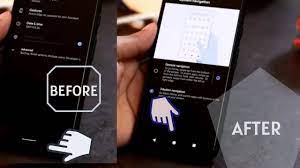Starting with Android 10, Google began moving its operating system more toward gesture navigation. But there’s no right or wrong approach—just the one you’re most comfortable with. Being aware of the options available and how they work, can help you figure out which one is best for you: You can go back to the three-button navigation mode, or even get a middle-ground option that combines buttons and gestures.
This is the way Android used to work for several years. At first, it was three physical buttons which have since—as bezels have shrunk—turned into three software buttons displayed on the screen itself.
Three-button navigation has long ceased to be Android’s default mode, but you can easily bring it back if you miss it. From Settings, go to System, Gestures, and then tap System Navigation. Gesture navigation will be selected by default, but you can tap 3-button navigation to make buttons appear at the bottom of your screen.
Most of the time, those three buttons are (from left to right on stock Android): Back, Home, and the oddly named Overview. Some flavors of Android, including Samsung’s, let you change the order of these buttons, but the principles are always the same.
This is perhaps the easiest option because you don’t have any gestures to learn. The Back button goes back, the Home button goes to the main home screen (on some phones you can hold it down to launch the Google Assistant), and the Overview button will show you apps you’ve used lately and let you switch between them—double-tap it to jump between the current app and the previously used one, and back again. To see all your apps, swipe up on the Home button.
This approach was introduced in Android 9 Pie in 2018, and you can think of it as a middle ground between the old and new navigation systems in Android. It’s no longer available on Android 12, but if your Pixel device is running an old version of the operating system, you still have this option if you don’t want to go all-in on either buttons or gestures.
The Back button keeps its place, but the Home button turns into a smaller pill shape, and the Overview button disappears completely. To get to the screen of recent apps, you’ll need to swipe up and hold the Home button. If you swipe up quickly from any other point of the screen, you’ll go to the full app drawer.
Quickly tapping the Home button will bring you to the main home screen, and pressing and holding it will launch the Google Assistant on compatible phones (including the Google Pixel). Swipe right quickly and briefly on the Home button to switch between your two most recent apps (the same as double-tapping the Overview button). The Back button works as it always has, taking you back to the previous screen, whether that’s in the current app or a different one.
This approach is an intuitive blend of buttons and gestures, and you’ll save a little bit more room on the screen with two buttons rather than three.
Source : https://www.popsci.com/android-gesture-navigation/









